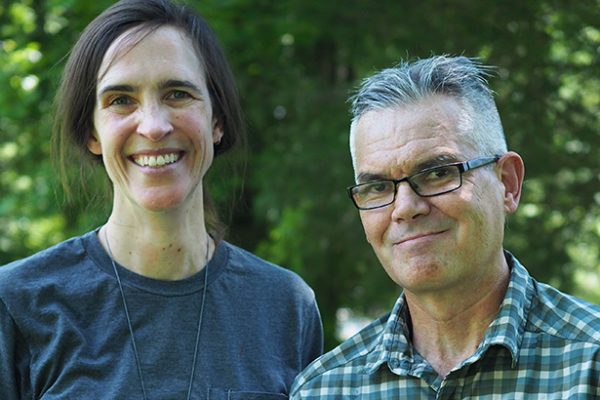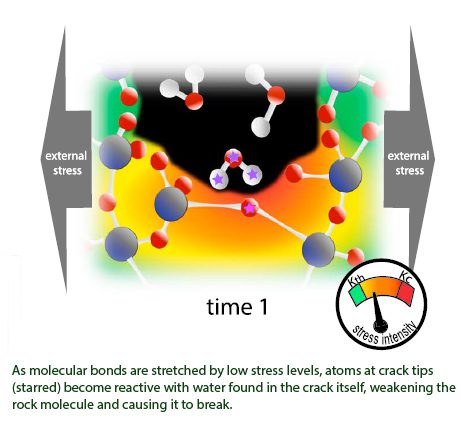Dr. Eppes and Dr. Keanini Pairing Leads To Significant Findings

Since 2012, the somewhat unusual research pairing of a geologist and mechanical engineer at UNC Charlotte has led to some important scientific results, and has recently earned recognition of their work with a top award for interdisciplinary research and publication.
Dr. Martha Cary (Missy) Eppes, professor of Earth Sciences in the Department of Geography and Earth Science, is a field geologist with 20 years of experience measuring natural cracks on rocks outdoors. Dr. Russ Keanini, professor in the Mechanical Engineering Department, has almost 30 years of experience as an expert in computational statistical analysis. Together, they are a team to be reckoned with as they combine their skill sets to figure out how the world works.
The Council of the Geological Society of America named Dr. Eppes and Dr. Keanini as winners of the 2020 Kirk Bryan Award for Research Excellence. The award was given in recognition of their outstanding contributions to the interdisciplinary field of Quaternary geology and geomorphology, and for their 2017 publication “Mechanical weathering and rock erosion by climate-dependent subcritical cracking,” in the Reviews of Geophysics.
The partnership between the geologist and the engineer began in 2012, when Dr. Eppes was exploring a puzzling dataset, and began looking for assistance with numerical modeling.
 “I was finding that cracks in rocks, even in places like very wet and cold Pennsylvania and wet and warm North Carolina, could be linked to stresses brought on by the daily heating and cooling from the sun,” Dr. Eppes said. “I was curious about the role that water played in this seemingly water-less thermal process.”
“I was finding that cracks in rocks, even in places like very wet and cold Pennsylvania and wet and warm North Carolina, could be linked to stresses brought on by the daily heating and cooling from the sun,” Dr. Eppes said. “I was curious about the role that water played in this seemingly water-less thermal process.”
That curiosity led her to fracture mechanics literature that showed when cracking occurs very slowly due to very low stresses in rock, water is a crucial component of actual molecular bond-breaking.
“Since most of the earth’s surface is dominated by such very low stresses (rocks are not shattering like vases all around us), I reasoned that all mechanical weathering must also proceed through these slow, subcritical processes,” Dr. Eppes said. “At the same time, I also hypothesized that the ‘environment’ dependence of subcritical cracking found in lab experiments would translate to a ‘climate’ dependence for natural mechanical weathering.”
The idea potentially represented an entirely new way of thinking of mechanical weathering and the factors that control it. “But, you can’t really sit around and wait for rocks to crack at such slow rates,” Dr. Eppes said, “so I realized that the main way I could test these hypotheses was through numerical modeling. Enter Russ!”
Based on Dr. Eppes’ hypothesis, Dr. Keanini developing a physical model, from basic physics principles and from existing lab data, for how rocks would weather and erode if they were doing so by climate-dependent subcritical cracking.
“With Russ’s model, and my analysis of existing published experimental data,” Dr. Eppes said, “we tested and supported the hypothesis that all rock mechanically weathers through climate-dependent subcritical cracking, which was the main conclusion of the 2017 paper.”
For the award-winning paper, their interdisciplinary research developed simple models, order-of-magnitude analyses, and statistical models of the physical mechanisms and environmental processes that produce “grain-scale subcritical cracking”.
“The sort of grain-scale subcritical cracking we were studying occurs at and near the surface of granular rock,” Dr. Keanini said. “It is produced by natural sources including solar-induced, cyclic thermal expansion and contraction, corrosion (bond weakening and breaking) by water, ingress of growing plants and trees, and wind, rain and fire. The paper considered the first two processes and focused on the growth of a single, small (millimeter- to centimeter-scale) surface or near-surface, inter-grain crack, driven by daily heating of the sun.”
The statistical models developed through Dr. Keanini’s engineering expertise were critical to making the geological discoveries possible.
“Russ was amazing,” Dr. Eppes said. “Though he has very little background in geology, he made numerous assumptions in his model that I was then able to justify using all my years of experience and field-data for natural rock cracking. I can’t recall an instance when one of his geological assumptions was not correct and supported by past work and data he had never seen. Russ and I are both extremely independent researchers from completely different disciplines, who are nevertheless able to seamlessly connect our work through our mutual love of figuring out how the world works.”
Dr. Keanini agrees with Dr. Eppes’ assessment of how well they mesh as researchers, even though they are from two vastly different disciplines. “Missy uses her extensive knowledge of rock weathering and fracture to define important and interesting questions that we can tackle as a team, taking advantage of our individual sets of skills,” he said. “As the leader of the project, she combined deep physical intuition, encyclopedic knowledge, and commitment to high standards to push us in directions that invariably led to new, important insights. I’ve had so much fun working with Missy. She’s a genuine, down-to-earth, perpetually kind person who also happens to be a world-class scientist.”